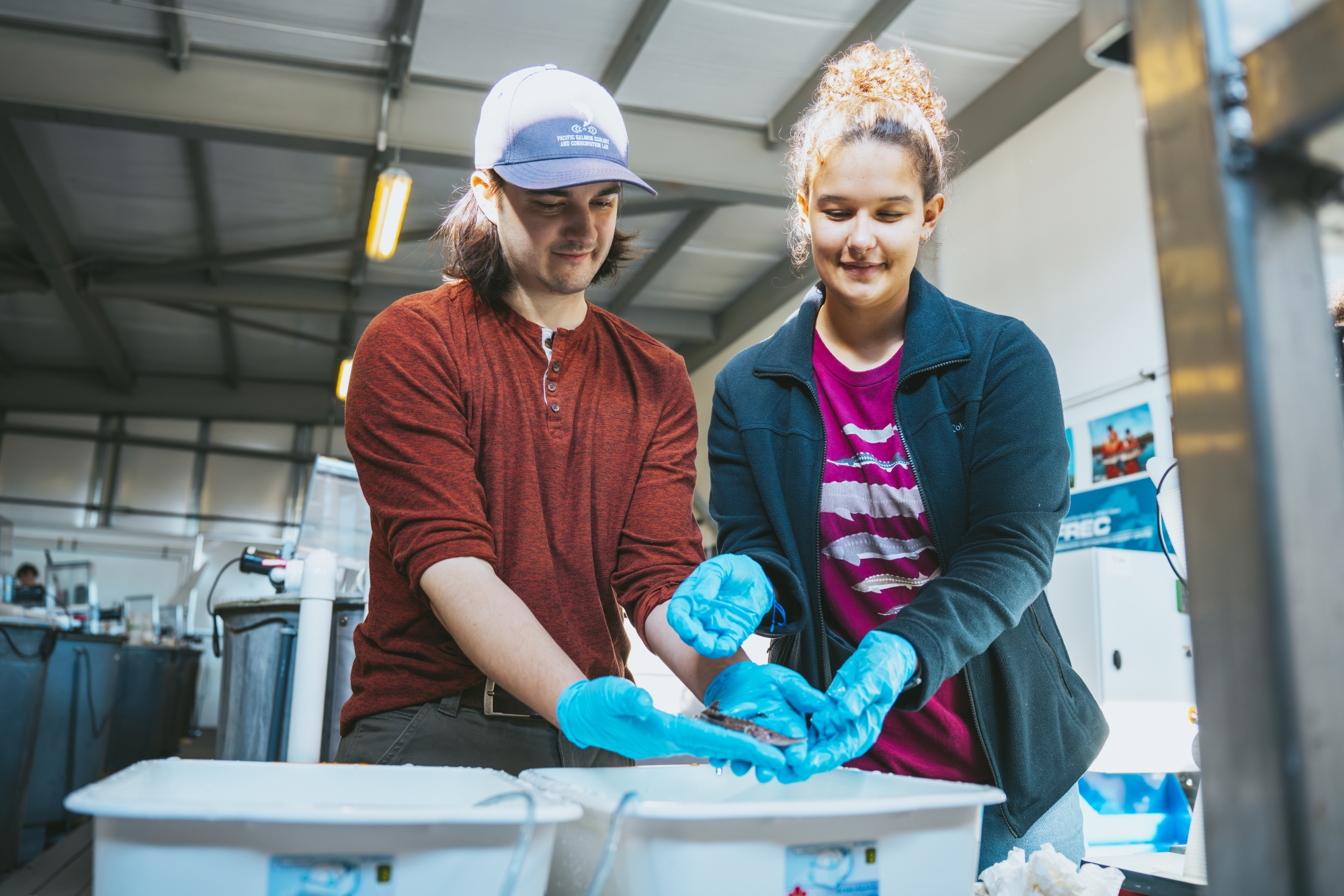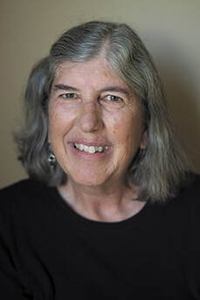 Grad student Olivia Galloway photographs the progress of juvenile sturgeon before their release into Great Lake waters.
Grad student Olivia Galloway photographs the progress of juvenile sturgeon before their release into Great Lake waters.
Lurking in the depths of the Great Lakes are massive “living fossils” that have been a vital part of the ecosystem for millions of years, but due to human intervention, have long been considered at risk.
That’s why Master of Science student Olivia Galloway is focusing her research on lake sturgeon. These prehistoric, scaleless fish are the largest freshwater fish in Canada, growing up to two metres long and weighing up to 200 pounds. She is working to improve their environment and help reintroduce these “dinosaurs” back into their habitats.
“We’re experimenting with different methods to enhance survival rates,” Galloway explained. “Right now, there are programs focused on raising juvenile fish in hatcheries and releasing them into the Great Lakes, but unfortunately, many do not survive. So, our goal is to find ways to enhance these reintroduction programs.”
Galloway, whose work is carried out in the Pitcher Lab at the Great Lakes Institute of Environmental Research (GLIER), explained that for hundreds of years, human pressures have contributed significantly to the issues facing these fish and their habitat. Overharvesting, the construction of dams, pollution, and climate change have all led to the decline of these important fish.
“Overfishing posed a large issue several hundred years ago, with fish being caught from the water despite being considered undesirable for consumption,” she said. “Additionally, the construction of dams has significantly fragmented the sturgeon’s habitat, obstructing their migration from lakes to rivers where they spawn.”
Galloway’s work lies in determining the best rearing environment for the hatchery and how it may influence their growth. For example, by adding rocks to the tanks, she is mimicking the natural riverbeds, such as those in the Detroit River, where sturgeon typically live and spawn.
“We're trying to see if by making it a little more natural in the hatchery, they will have better chances of survival afterward. While I haven’t seen any concrete results yet, they are growing, which is good news,” Galloway said.
This work is part of a larger international collaboration with the U.S. Fish and Wildlife Service.
“The goal is to eventually release them and see how they fare. If we find that adding structures to their habitat helps them, we can inform our partners who manage sturgeon hatcheries and hopefully boost their survival rate. Right now, only about one per cent survive once they’ve been released.”

Preserving Living Fossils
Sturgeon have been a part of the ecosystem for millions of years, and in that time, their body plan has remained largely unchanged, Galloway said.
“They haven’t evolved much because their existing traits suit them well,” she noted. “If you were to examine fossils of sturgeon from the past, they would closely resemble present-day sturgeon because they are resilient fish. They’ve existed for a very long time, and our goal is to ensure their continued survival for even longer.”
Sturgeon have a sort of vacuum mouth and gather their food from the bottom of the river or lake, transferring that energy up to the top. They also eat invasive species such as gobies and mussels and are considered a “keystone species” in the Detroit River.
“Essentially the ecosystem can’t really live without them,” Galloway said. “That’s why we’re concerned about them potentially going extinct.”
These ancient fish are not only key to the Great Lakes environment but also hold special cultural significance to the Indigenous peoples of the area.
“Lake sturgeon served as a food source and has also been included in stories and special ceremonies,” she explained.
Professor Trevor Pitcher, who established and runs the Freshwater Restoration Ecology Centre at GLIER, said since these important fish have been around for so long, we don’t know what the ecosystem would look like without them.
“This is a six-foot animal that lives 100 years; it’s the closest thing to touching dinosaurs,” Dr. Pitcher said. “These sturgeons are so old, they were swimming around when your grandparents were born.”
Navigating the Waters
Galloway has long had an interest in these dinosaurs of the Great Lakes. Ever since she was given a book highlighting the life cycle of white sturgeon and their status as an at-risk species, she was hooked on the “iconic fish.”
As an undergraduate, Galloway had the opportunity to work with at-risk turtles at Parks Canada, prompting her passion for species at risk and launching her path toward a career as a conservation biologist.
She said she “got her hands dirty” working in conservation for the Department of Fisheries and Oceans for a while, sparking her to continue her studies at the Pitcher Lab, which explores evolutionary biology, reproductive ecology, and conservation biology using fish from the Great Lakes basin as well as both the east and west coasts of Canada.
“It’s the most well-known lab in Ontario for aquatic research. So, I reached out to Dr. Pitcher, the expert on all things fish, and asked if we could get sturgeon. He said, ‘We can make that happen,’ and with help from our partners at the U.S. Fish and Wildlife Service, we now have 200 baby sturgeon,” Galloway said. “It’s been a dream come true since then.”
Pitcher said he and those at the lab have been working with their U.S. partners for quite some time, realizing they had to do something and couldn’t keep watching the sturgeon populations dwindle. They joined a program to supplement the fish and reintroduce them; however, they weren’t surviving.
“So, we get on the boats with the U.S. Fish and Wildlife Service. I bring Olivia or other grad students with me, and they come on the boat with no experience, but we train them how to safely work with adult sturgeon, how to collect the eggs, and how to do all the work from scratch. The best part is they get in-field science lessons and hands-on experience,” he said.
From there, Galloway continues her work to finesse the sturgeon’s environment to determine best practices to keep them thriving and give them the best opportunity for survival once reintroduced, which Pitcher said will make waves far beyond this project.
“The research itself is important,” he said. “But what I think is unusual about her work is that it’s not just cool science that she’ll produce and publish, but it changes the way they do business in terms of policy and how they will release the fish in the future. It’s being applied almost immediately after she finishes her work in the real world. She’s doing fundamental science that federal agencies will apply right away.”
As part of her thesis, Galloway will be releasing the sturgeon this week with the Wildlife Service using hard- and soft-release strategies.
Securing the Future
The researchers at GLIER are taking an active part in not only protecting sturgeon but also other species at risk and educating the public about them. According to Pitcher, freshwater species are in more trouble than those living in our oceans but don’t get the same attention.
“They call it the ‘invisible collapse’ as the freshwater systems are falling apart to some extent, much faster than the marine system, but they don’t get the same attention because marine ecology, sharks, and orca whales are very attractive to people,” he explained.
And the unique thing about Windsor-Essex, Pitcher said, is that it’s surrounded by the most at-risk set of freshwater fishes in the country.
“In the River Canard, for example, we have these things called pugnose minnows, and the only large population in Canada that’s sustainable is right there,” he said. “And of course, we have the lake sturgeon in the river and lakes, all right in our own backyard.”
Seeing the need to protect these and many other species is what prompted Pitcher to establish his lab in the Windsor area nearly two decades ago.
“We’re doing things that nobody else is really doing, and we’ve been mapping this out for years,” he said.
“Since I work to take species off the endangered or at-risk list, the irony is my goal is to work myself out of a job.”
While there’s still much to be done, he said he is working to lay the groundwork for the future generation, getting researchers like Galloway and other talented students ready to take on this important work.
“When you talk about species at risk, it’s important to recognize these are multi-generational problems. This isn’t something that will be solved in the next five or 10 years. It’s the next 25 to 30 years,” Pitcher said. “I’m actively recruiting students who are passionate about these questions, providing them with the necessary skills and access to equipment that’s not available elsewhere in Canada. That way, they get the experience they need to get hired by agencies to help solve these problems.”
To learn more about GLIER and the ways its researchers are contributing to the protection of our water systems, visit uwindsor.ca/glier.





 UWindsor nursing alumna Nancy Edwards (BScN 1974) worked as a community health nurse in the west African country of Sierra Leone for five years in the late 1970s and early 1980s.
UWindsor nursing alumna Nancy Edwards (BScN 1974) worked as a community health nurse in the west African country of Sierra Leone for five years in the late 1970s and early 1980s.



